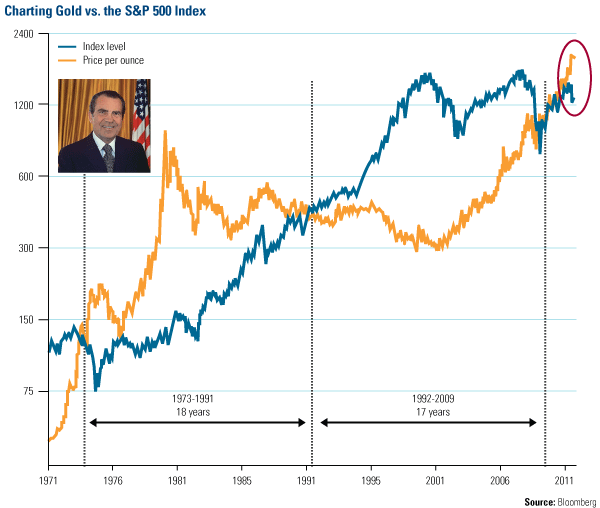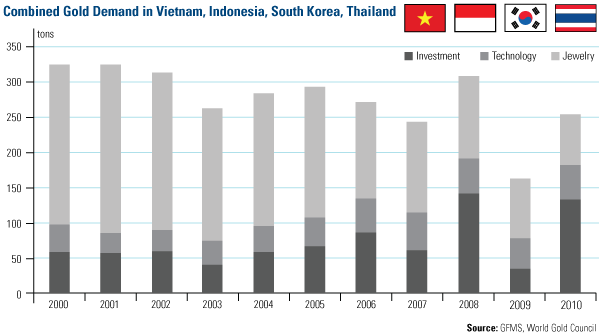Gold is due for a correction. It would be a non-event to see a 10 percent drop in gold and this would actually be a healthy development for markets by shaking out the short-term speculators while the long-term story remains on solid ground. [Indeed, were] gold’s relative value to return to 1979-1980 peak levels of 7.6 times the S&P 500, gold would have to hit the $10,000 mark. [Let me explain further.] Words: 1316
So says Frank Holmes (www.usfunds.com) in an article* which Lorimer Wilson, editor of www.munKNEE.com (It’s all about Money!), has further edited ([ ]), abridged (…) and reformatted below for the sake of clarity and brevity to ensure a fast and easy read. Please note that this paragraph must be included in any article re-posting to avoid copyright infringement. Holmes goes on to say:
Gold vs. the USD
Forty years ago this week, President Richard Nixon “closed the gold window,” ending the gold-backed global monetary system established at the Bretton Woods Conference in 1944 and kicking off a decade of stagflation for the U.S. economy…One U.S. dollar now buys only 2 cents worth of the gold it could buy in 1971 meaning that consumers have lost roughly 98 percent of their purchasing power compared to gold over the past 40 years. [Read this article (1) on the relationship between the USD and the price of gold.]
Gold vs. the S&P 500
The U.S. dollar isn’t the only asset gold has outperformed during recent decades. The yellow metal has also seen periods of relative strength against the S&P 500. This chart from Gold Stock Analyst pits the performance of gold bullion against the S&P 500 since 1971—you can see that gold immediately rallied following Nixon’s announcement before peaking at $850 an ounce in 1980. At that price, one ounce of gold was 7.6 times greater than the S&P 500, according to Gold Stock Analyst. Gold’s relative performance then declined for the next 20 years, with the S&P 500 taking the lead in 1992 and peaking at 5.3 times the value of gold in 1999. Currently, gold’s value is roughly 1.6 times greater than the S&P 500. [Read this article (2) for more on this relationship.]

What drove gold’s relative underperformance from 1980 to 1999? It was a shift in government policies, which have historically been precursors to change…
Gold and Real Interest Rates
The Federal Reserve Chairman Paul Volcker began steering the U.S. economy toward positive real interest rates in 1980 and Volcker’s goal was met in 1992—the same year the S&P 500 overtook gold.
In order for gold’s relative value to return to 1979-1980 peak levels of 7.6 times the S&P 500, Gold Stock Analyst’s John Doody says gold prices would have to hit the $10,000 mark. Obviously that scenario is unlikely, but it does put all this “gold bubble” nonsense into perspective. [Read this article (3) for more on the future price of gold.]
One point to pop the “gold bubble” talk is that negative real interest rates are poised to stick around for a while…Negative real interest rates—one of the main drivers of the Fear Trade—have historically been a miracle elixir for higher gold prices. The magic number for real interest rates is 2 percent. That’s when you can earn more than 2 percent on a U.S. Treasury bill after discounting for inflation. Our research has shown that commodities tend to perform well when rates fall below 2 percent.
Who in the world is currently reading this article along with you? Click here to find out.
Take gold and silver, for example, which have historically appreciated when the real interest rate dips below 2 percent. Additionally, the lower real interest rates drop, the stronger the returns tend to be for gold. On the other hand, once real interest rates rise above the 2 percent mark, you start to see negative year-over-year returns for both gold and silver. [Read this article (4) for more on the subject.]
It’s important to point out that it is the political policies not political parties that drive this phenomenon. During the 1990s, when President Clinton was in office, there was a budget surplus and investors could earn more on Treasury bills (about 3 percent) than the inflationary rate (about 2). This gave investors little incentive to embrace commodities such as gold, and prices hovered around $250 an ounce.

Since 2001, increased regulation in all aspects of life, negative real interest rates, welfare and entitlement expansion funded with increased deficit spending have created an imbalance in America’s economic system. It’s this disequilibrium between fiscal and monetary policies that drives gold to outperform in a country’s currency. Today, the Fed capped interest rates near zero back in 2008 and the federal budget deficit has ballooned to $1.4 trillion. In fact, both the deficit as a percentage of GDP (negative 11 percent) and federal government debt as a percentage of GDP (nearly 65 percent) are at the highest levels since 1950, Citigroup research shows. This has helped fuel gold’s rise through $1,000, $1,500 and now $1,800 an ounce.
Gold and Increased Demand
This is only one side of gold’s long-term story. Another point to pop the “gold bubble” talk is that we’re entering what has historically been gold’s strongest period of the year in terms of demand. In the past, gold prices have bottomed in August but recently gold’s strong seasonal period has extended into the dog days of summer as the holy Muslim holiday of Ramadan moves forward on the calendar by 10 days each year. This year Ramadan began August 1.
In its latest Gold Demand Trends report, the World Gold Council (WGC) confirmed that the Love Trade is burning bright in Asia. The WGC council said Chinese and Indian buyers continue to be the “predominant drivers” of gold demand, accounting for “52 percent of bars and coins and 55 percent of jewelry demand.” China’s demand grew 25 percent, while India saw an increase of 38 percent. WGC attributes this growth to “increasing levels of economic prosperity, high levels of inflation and forthcoming key gold purchasing festivals.” [Read this article (5) on the influnce of Asia on the price of gold.]
But China and India aren’t the only emerging markets feeling the love for gold. Vietnam, Indonesia, South Korea and Thailand – labeled by the WGC as the “VIST” countries – are additional key gold-consuming countries.
The WGC’s chart below shows a potential opportunity in increased demand for gold, especially in jewelry, in the VIST countries. In 2010, demand rose to 253 tons after a sharp drop in 2009. Jewelry demand, however, was historically low while investment demand grew considerably.

Similar to China and India, the VIST countries have had a 2,000-year long relationship with gold which is intertwined in their culture, religion and economy. Jewelry and investment demand are one and the same, says the WGC: “The demand for gold as a store or accumulator of wealth, as an auspicious gift or as insurance against unforeseen risks, is to a large extent independent of the form it takes.” This strong tie to gold means that, as wealth among residents of Vietnam, Indonesia, South Korea and Thailand increases, price is less of a consideration, and gold will continue to be at the top of their shopping lists.
Conclusion
At some point in the future gold prices will fall, that’s for certain. However, don’t expect it to happen soon. We believe the one-two punch of the Fear Trade and Love Trade will keep gold prices at elevated levels for another few years.
*http://www.usfunds.com/investor-resources/investor-alert/
Titles and Links to Articles Referenced in Article Above:
- Why the USD Index Could Fall to 65 and Gold Rise to…
- S&P 500 – to – Gold Ratio Suggests a Maximum High of $7,275 for Gold
- Update: These 90 Analysts Believe Gold Will Go To $5,000 ozt. – or More
- The Future Price of Gold and the 2% Factor
- Asian Demand for Gold & Silver Will Cause Much Higher Prices – Here’s Why
Editor’s Note:
The above article consists of reformatted edited excerpts from the original for the sake of brevity, clarity and to ensure a fast and easy read. The author’s views and conclusions are unaltered.
Permission to reprint in whole or in part is gladly granted, provided full credit is given as per paragraph 2 above.
 munKNEE.com Your Key to Making Money
munKNEE.com Your Key to Making Money